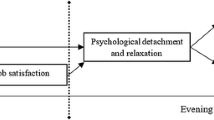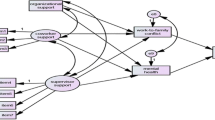Abstract
Flow at work was associated with optimal psychological outcomes in the organizational setting. However, previous studies have concentrated on work-related flow as an outcome rather than a catalyst of positive psychological functioning. Further, the differential impact of work-related flow domains on key outcomes was still uncharted. To address this empirical gap, the current investigation examined work-related flow dimensions as differential predictors of anxiety, life satisfaction, and work longevity among 133 Filipino guidance counselors. The results of hierarchical regression analyses have shown that work enjoyment served as a robust predictor of anxiety, life satisfaction and work longevity even after controlling for the influence of relevant demographic variables. Absorption positively predicted work longevity. However, intrinsic work motivation did not predict any outcome. Discussion points revolved around the unique theoretical contributions of the current study to the foregoing work-related flow theory and concrete practical implications to emphasize the psychological benefits of work-flow especially in the field of counseling.
Similar content being viewed by others
References
Bakker, A. B. (2005). Flow among music teachers and their students: the crossover of peak experiences. Journal of Vocational Behavior, 66, 26–44.
Bakker, A. B. (2008). The work-related flow inventory: construction and initial validation of the WOLF. Journal of Vocational Behavior, 72, 400–414.
Bernardo, A. B. I. (2008). Individual and social dimensions of Filipino students’ achievement goals. International Journal of Psychology, 43, 886–891.
Catley, D., & Duda, J. L. (1997). Psychological antecedents of the frequency and intensity of flow in golfers. International Journal of Sport Psychology, 28, 309–322.
Colombo, L., & Zito, M. (2014). Demands, resources, and the three dimensions of flow at work: a study among professional nurses. Open Journal of Nursing, 4, 255–264.
Csikszentmihalyi, M. (1975). (2000 – 25th anniversary edition). Beyond boredom and anxiety. In Experiencing flow in work and play. San Francisco: Jossey-Bass.
Csikszentmihalyi, M. (1990). Flow: the psychology of optimal experience. New York: HarperCollins.
Csikszentmihalyi, M. (1997). Finding flow: the psychology of engagement with everyday life. New York: HarperCollins.
Csikszentmihalyi, M., & Csikszentmihalyi, I. S. (Eds.) (1988). Optimal experience: psychological studies of flow in consciousness (Eds ed., ). New York: Cambridge University.
Datu, J.A.D. (2014). Validating the Revised Self-Construal Scale in the Philippines. Current Psychology. Advance online publication. doi:10.1007/s12144-014-9275-9.
Datu, J.A.D. & Mateo, N.J. (2015). Perceived autonomy support moderates the relations between counseling self-efficacy and flow among Filipino counselors. Current Psychology. Advance online publication. doi:10.1007/s12144-015-9358-2.
Demrouti, E. (2006). Job characteristics, flow, and performance: the moderating role of conscientiousness. Journal of Occupational Health Psychology, 11(3), 266–280.
Diener, E., Emmons, R. A., Larsen, R. J., & Griffin, S. (1985). The satisfaction with life scale. Journal of Personality Assessment, 49, 71–75.
Fong, T., & Ng, S. (2012). Measuring engagement at work: validation of the chinese version of the utrecht work engagement scale. International Journal of Behavioral Medicine, 19(3), 391–397.
Graves, L. M., Ruderman, M. N., Ohlott, P. J., & Weber, T. (2012). Driven to work and enjoyment of work: effects on managers' outcomes. Journal of Management, 35, 1655–1680.
Jackson, S. A., & Roberts, G. C. (1992). Positive performance states of athletes: toward a conceptual understanding of peak performance. The Sport Psychologist, 6, 156–171.
Johnstone, A., & Johnston, L. (2005). The relationship between organizational climate, occupational type, and workaholism. New Zealand Journal of Psychology, 34, 181–188.
King, R. B., & McInerney, D. M. (2012). Including social goals in achievement motivation research: examples from the Philippines. Online Readings in Psychology and Culture, 5(3).
Littman-Ovadia, H., & Balducci, C. (2013). Psychometric properties of the Hebrew version of the utrecht work engagement scale (UWES-9). European Journal of Psychological Assessment, 29(1), 58–63.
Mäkikangas, A., Bakker, A. B., Aunola, K., & Demerouti, E. (2010). Job resources and flow at work: Modelling the relationship via latent growth curve and mixture model methodology. Journal of Occupational and Organizational Psychology, 83, 795–814.
Markus, H., & Kitayama, S. (1991). Culture and the self: implications for cognition, emotion, and motivation. Psychological Review, 98, 224–253.
Marteau, T. M., & Bekker, H. (1992). The development of a six-item short-form of the state scale of the Spielberger State-Trait Anxiety Inventory (STAI). British Journal of Clinical Psychology, 31, 301–306.
McMillan, L. H. W., Brady, E. C., O’Driscoll, M. P., & Marsh, N. V. (2002). A multifaceted validation study of Spence and Robbins’ (1992) workaholism battery. Journal of Occupational and Organizational Psychology, 75, 357–360.
Munir, F., Houdmont, J. H., Clemes, S. A., Wilson, K., Kerr, R., & Addley, K. (2015). Work engagement and its association with occupational sitting time: results from the Stormont study. BMC Public Health, 15, 30.
Ryan, R. M., & Deci, E. L. (2000). Self-determination theory and the facilitation of intrinsic motivation, social development, and well-being. American Psychologist, 55, 68–78.
Salanova, M., Bakker, A. B., & Llorens, S. (2006). Flow at work: evidence for an upward spiral of personal and organizational resources. Journal of Happiness Studies, 7, 1–22.
Schaufeli, W. B., Salanova, M., Gonzalez-Roma, V., & Bakker, A. B. (2002). The measurement of burnout and engagement: A confirmatory factor analytic approach. Journal of Happiness Studies, 3, 71–92.
Zubair, A., & Kamal, A. (2015). Work related flow, psychological capital, and creativity among employees of software houses. Psychological Studies, 60(3), 321–333.
Author information
Authors and Affiliations
Corresponding author
Ethics declarations
Conflict of Interest
The present study was funded by the University Research Coordination Office of De La Salle University – Manila, Philippines under Project No. 19FU 1TAY12 3TAY13.
Ethical Approval
All procedures performed in studies involving human participants were in accordance with the ethical standards of the institutional and/or national research committee and with the 1964 Helsinki declaration and its later amendments or comparable ethical standards. This article does not contain any studies with animals performed by any of the authors.
Informed Consent
Informed consent was obtained from all individual participants included in the study.
Rights and permissions
About this article
Cite this article
Datu, J.A.D., Mateo, N.J. Work-Related Flow Dimensions differentially Predict Anxiety, Life Satisfaction, and Work Longevity among Filipino Counselors. Curr Psychol 36, 203–208 (2017). https://doi.org/10.1007/s12144-015-9401-3
Published:
Issue Date:
DOI: https://doi.org/10.1007/s12144-015-9401-3




